
KISLEV 5770 fxku gW,a Certified Soul Nutrition
3 4 5 9 10 12 13 14 16 18 20 22 23
ShAre Your SpiriT QueSTioNS for The ~
CheeSe De-LighT
By Rabbi Yitzchak Gornish
8 uSeS for fire
KoSher piCKLe
By David Brown
heALThY SpiriT
Chanukah reCipe
LeT’S geT CooKiN’
phoTo gALLerY annual Mashgichim Conference
Who’S BehiND The ~ iNTervieW
With Rabbi Yitzchak Gornish
107 WAYS ~ KoShereD
Your WorLD iN 2009
ChassidiC iNSighTS: Chanukah: viCTorY of The SouL
Compiled by Dina Fraenkel
SouL NuTriTioN
We welcome your comments, submissions and letters to the editor.
Mail: 391 Troy Avenue
Brooklyn, NY 11213
E-Mail: editor@kosherspirit.com
EDiTOR-iN-CHiEF:
rabbi Chaim fogelman
EDiTOR: Dovi Scheiner
aSSOCiaTE EDiTOR: Dina fraenkel
DESiGN:
Dear Reader,
as the month of Kislev is upon us, I can’t help but think about the horrific atrocities that took place in Mumbai and realize that a year has already passed.The kedoshim that were murdered in the Chabad House, solely because they were Jewish, had very close ties with the world of kashrus.Rabbi LeibishTeitelbaum (Hy”d) and Rabbi Benzion Kruman (Hy”d) were visiting mashgichim who were in Indiato inspect food production facilities and Rabbi Gavriel Holtzberg (Hy”d), the Chabad shliach in Mumbai, was an ~ Kosher representative who made full-time, regular inspections on behalf of the ~. Rabbi Holtzberg monitored many facilities to ensure that the kashrus was maintained at the highest kosher level possible.
It seems like just yesterday that one of the secretaries in the ~ New York office mentioned that she spoke to Rabbi Holtzberg earlier … and he just doesn’t answer his phone anymore… This was on Wednesday and on that very Motzei Shabbos, just three days later, a New Yorkrabbi from our main office was scheduled to fly to Mumbai to meet with Rabbi Holtzberg. Over the next day or two, much to our chagrin, we all learned of the terrible situation that these holy and innocent peoplewere in. (The ~ has since set up a new office in Mumbai with a steady flow of rabbis coming in from Israel.)
Those of us who work in the kashrus arena know that without the Chabad shluchim throughout the world, kashrus would not be where it is today. All of the different kashrus agencies rely on these dedicated rabbis to monitor food factoriesin the most distant and remote locations, and all of us, the kashrus agencies and the kosher consumers as a whole, owe a great debt of gratitude to them.
At this time of the year, when we spread light into the darkness by lighting the Chanukah candles, let’s remember these eternal flames. May Hashem spread His light upon us all and dispel the darkness forever with the coming of Moshiach
Hum chaehay Moshiach abee! (“We want Moshiach now!” in Urdu, one of the languages of India.)
Rabbi Chaim Fogelman
Editor-in-Chief
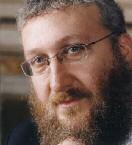
2• www.OK.org
www.SpotlightDesign.com
Share Your Spirit
Readers share their thoughts about the last issue...
Dear Kosher Spirit, Y
asher Koach to Chazzan Sherwood Goffin for his brilliant and timely article “Kosher Music - The Music of the Yomim Noraim.” I read it Erev Rosh HaShanah and found it engaging and informative. Unfortunately we are witnessing a time when too many shuls are avoiding hiring a trained and knowledgeable chazzan in favor of someone whose experience with Jewish music is limited to being a singer at weddings and Bar Mitzvos and has little or no training in what is obviously a very specialized field and sacred responsibility. Like the sound of the shofar, I hope Chazzan Goffin’s article will be a wake up call to these synagogues, and that no matter where one finds themselves for the Yomim Noraim, they will hear the appropriate nusach that has been used for generations.
Marsha Greenberg, Englewood, New Jersey
Dear Kosher Spirit,
in the Tishrei 5770 issue, in the article “How Sweet It Is,” on page 15, it says the earliest recording of cane sugar collecting was in the 14th century in Arabia. The Rambam in Hilchos Brochos 8:5 describes the process of making sugar from sugar cane and discusses different opinions as to the correct Brocha Rishona to say on it. The Rambam wrote his Mishneh Torah at the end of the 12th century, and he is quoting the opinion of the Geonim who came before him. Clearly the practice predated the Rambam considerably.
Don Greenberg, Lakewood, NJ
rabbi gornish responds:
Dear Mr. Greenberg,
Thank you for your letter regarding my article, “How Sweet it is.” You wrote that the RaMBaM mentions sugar in the Mishneh Torah. While this is true, the sugar referred to by the RaMBaM was a coarse sugar that did not have much resemblance to today’s sugar. in fact, the earliest mention of some type of sugar was in the fourth century, around the time of the completion of the Talmud Yerushalmi! The sugar first mentioned in 14th century arabia, on the other hand, was a refined sugar that was analogous to the table sugar we use today. That is why i wrote that the first mention of sugar was in 14th century arabia.
Dear Kosher Spirit,
Cantor Goffin’s article is an important document whose content should be shared with all who approach the amud to act as Shliach Tzibur. Many who approach the amud seem to forget that their “job” has a number of important facets such as Kovod HaBrios, Kovod HaTefillos and Tircha HaTzibur. They have a duty to be as pleasant and melodic as possible and, maybe, should not act as Baalei Tefilah if they do not have melodic voices. Additionally, there is a nusach tradition, which many ignore or are not aware of. There are times when the Rav of the kehillah, who we must assume is davening with true kavana, yet does not have a melodic voice, insists upon acting as Shliach Tzibur during Moadim and Shabbosim. Is there a way to get this message across without embarrassment or hurt? Should not the Rav of a kehillah be sensitive to this important caveat?
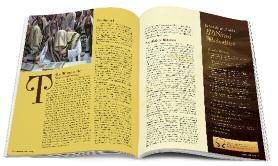 Joe Polansky
Joe Polansky
Chazzan goffin responds:
Thank you for your interest in the very important topic of Nusach HaTefillah and the responsibilities of the Shliach Tzibbur The Shulchan Oruch OC 53:4 says that the chazzan must have a sweet voice and be “Mrutsah L’Kohol” – acceptable to the congregation. it also says in 53:5 that if no one with all the qualifications can be found, choose the one with the most wisdom and good deeds. Therefore, it has become somewhat of a minhag for many shuls to have the rabbi daven, even if he doesn’t have a good voice. The Rama is quoted as saying –when it comes to the Yomim Noraim one must be strict and appoint the one most qualified in Torah and good deeds (Rama on Orach Chaim 571:1). also, when there are two candidates and one is a Torah Scholar, he gets preference-Mishna Brurah on the previous citation.
So, it has become a “minhag” to ask the rabbi to daven, and most of the time he will refuse if he has a bad voice or doesn’t know the nusach. The one area that has become traditional for every rabbi – qualified or not – is Neilah. in Europe the rabbi always davened Neilah. Hopefully, he knew what he was doing! if we are members of a shul and its board we can make somewhat of an impact to insist on standards. it has to be done WiTHiN the shul. Outsiders or non-board members cannot be and are not effective in this area. We have to educate the public, and that is what i’m trying to do with my articles.
Thank you again and Shalom — Sherwood Goffin
feeDBACK
The ~ receives many letters/emails with kosher questions...

Dear ~
,
Why are all or most parts of a cow kosher for consumption in israel, whereas the Jews in America are forbidden to eat anything behind a cow’s waist?

(for example, beef tenderloin, which is used for fillet mignon steaks or kabobs.)
rabbi Krinsky responds:
There are some fats, veins, & nerves that may not be eaten & must be removed from the meat of a cow before the meat is soaked & salted. Some of these are in the front quarters, but most are in the hindquarters.
in israel there are a few expert butchers that have been trained to remove these and still save some parts of the hindquarters for consumption. Many of the better cuts are in fact damaged during this process, but since meat is so expensive and hard to get in israel, they take the time to get whatever they can. additionally, there are not as many non-kosher consumers
(percentage-wise) in israel to buy the traditionally expensive cuts of the hindquarters (without proper de-veining) at a viable price.
On the other hand, here in the United States, labor is more expensive, there is enough kosher meat (from the front quarters that do not have that many issues), and most importantly there are many non-Jewish consumers to sell the hindquarters to, so it is not commercially viable to work on the hindquarters. The percentage of kosher consumers to non-kosher consumers here in the U.S. is much smaller than in israel. The front quarters are de-veined and certain fats removed here in the U.S. The front quarter cuts remain viable even after de-veining.
One of the major Glatt Kosher suppliers here in the U.S. tried to de-vein and then soak and salt hindquarters (and actually brought in special butchers from israel to work on the meat) but gave up after a while due to losing a lot of money. They received more money from the non-de-veined hind quarters cut up & sold as non-kosher than they received from the ones that went through the kosher process (to take out the veins and fats).
Due to the above complications, for many generations, certain communities have taken upon themselves to only eat the front quarters of the cow.
4• www.OK.org
Cheese
it is a Jewish custom to partake of cheese during the festival of Chanukah. 1 This is to commemorate the Jewish heroine, Yehudis, who during the Syrian-Greek occupation of EretzYisroel plied a highly ranked enemy officer with rich cheese and wine and during the tyrant’s drunken stupor, she decapitated this hapless official. after losing their leader, the enemy troops fled in panic.2

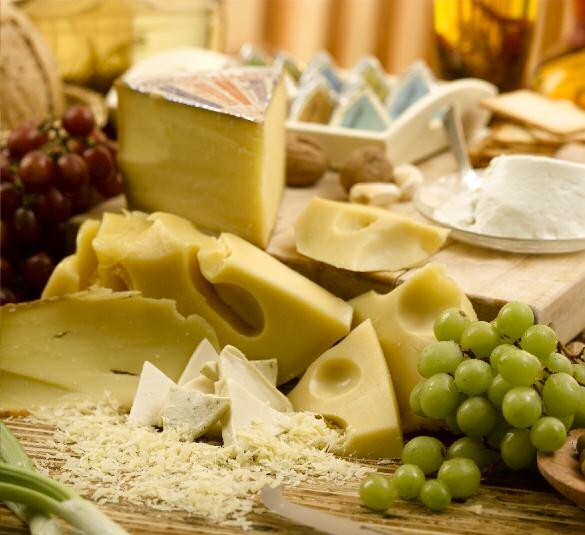 By Rabbi Yitzchak Gornish
By Rabbi Yitzchak Gornish
Cheese is a very historical food, found on Egyptian tomb murals and depicted in ancient cave etchings. Despite its ancient heritage, it is interesting to note that cheese is only mentioned three times in all of Tanach – twice regarding Dovid HaMelech3, and only once using its common name, gevinah, in Iyov (Job)4.
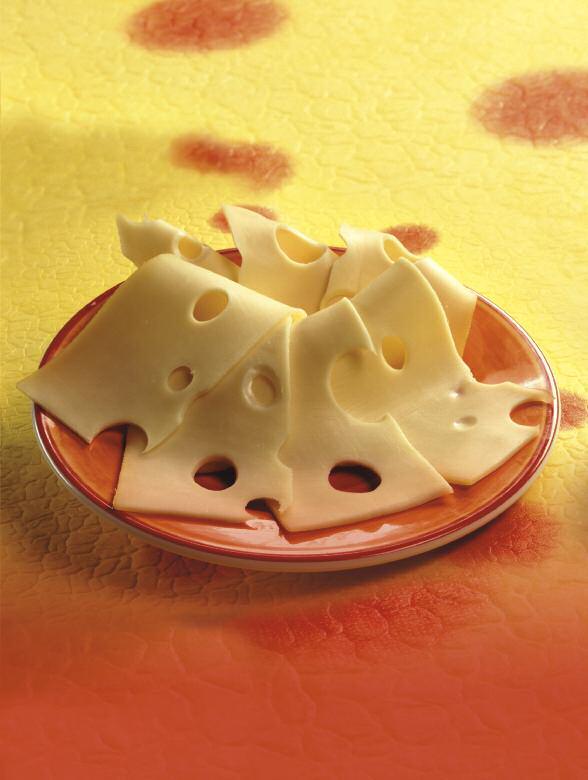
Cheese, however, is the subject of much rabbinic discussion. Following a rabbinic edict, Chazal forbade the


www.OK.org • 5
consumption of cheese produced by a Gentile.5 There are several concerns that prompted the rabbis to forbid this, including the suspicion that the cheese might be smeared with non-kosher fats or that nonkosher milk was used in making the cheese. However, the accepted reason is because non-kosher rennet (more on this later) was utilized by Gentiles to produce cheese.
This ban was even extended as an across the board prohibition to Gentile-produced cheese utilizing herbs and flowers.6 Rabbinic bans such as this can only be overturned if a later body of rabbis best the earlier group in scholarship and number. Unfortunately, as Torah knowledge weakens with every generation, overturning this prohibition is next to impossible even as circumstances change and it is no longer common to utilize nonkosher additives to produce cheese.7 Even if one relies on the leniency of consuming non-Cholov Yisroel milk, there are no loopholes for Gentile cheese.8
The rabbinic ban on Gentile cheese is not as far reaching as it originally appears. One first must decide on the definition of cheese prohibited by the ban.
The History of Cheese
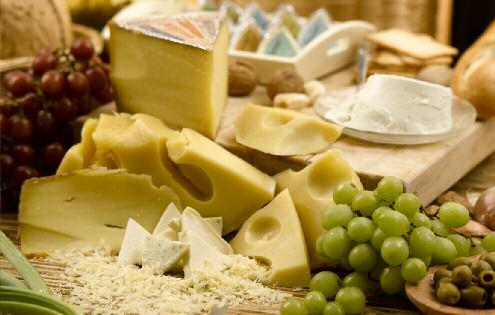
Popular lore has it that cheese was discovered early in human history by a traveler who fashioned a saddlebag from the lining of a calf stomach which he filled with milk for his journey. Arriving at his destination, he discovered that the bag was instead filled with a lumpy, white foodstuff. He had no idea that the enzymes in the lining, plus the agitation during travel, caused the milk to convert to cheese. This is because milk is actually a delicately balanced emulsion, which is a water solution with tiny globules of protein, fat, minerals and sucrose, suspended within by different chemical bonds. The enzymes in a calf’s stomach help it digest its mother’s milk by breaking down the milk into different components.
When calf rennet is introduced to milk it becomes prone to spoilage, as different airborne bacteria will quickly begin to produce acidic byproducts. One way to avoid spoilage is to introduce desired bacteria before the rennet is added to begin the milk breakdown, or by curdling (adding salt to the curds or soaking the cheese blocks in brine), which will then crowd out any
harmful bacteria that can take hold. Sometimes an acid such as vinegar is used to curdle milk as well. The rennet mostly serves as a coagulator, which causes the curd (the proteins in the cheese) to clump together trapping desired fats in those particles. The resulting liquid, or whey, byproduct is a common dairy bakery ingredient.
As an aside, while Gentile cheese is not kosher, the whey resulting from the curdling can in fact be kosher, provided that the cheese is produced at an acceptably low temperature as not to affect the kosher status of the whey. The cheese industry has even switched to starter cultures that prefer lower temperature so that the whey can be used in kosher products.
Some cheeses, such as ricotta, cream cheese9, and farmer cheese only contain vinegar or starter cultures and as such were never included in the rabbinic ban since the concern was a rennet based coagulation which these cheeses do not possess. Cottage cheese, which does contain rennet, is also not covered by the ban according to accepted sources, since the function of the rennet is only to speed up the cur-
6• www.OK.org
dling and not because of the coagulation attributes.10 Today, cheeses originally produced with calf rennet are now largely produced with microbial enzymes, which serve the same purpose, but of course they are still subject to the rabbinic ban on Gentile cheese.
Kosher Cheese

An apparent question that might occur to the reader is, “Why isn’t kosher calf rennet prohibited since it results in a mixture of milk and meat, which is a Biblical prohibition?” While some authorities go about tackling this issue by insisting the rennet to be completely dried out as to render it no longer meat11, many authorities frown on this solution12. In fact, before the introduction of microbial rennet, the only acceptable method of producing cheese, aside from herbs, was to use partly digested milk found in the stomach of a calf after being properly slaughtered.13 As the timing of the slaughter must have had to be
soon after the calf had eaten and this substitute rennet was prone to spoilage. It is fortunate that today modern kosher cheese is produced with microbial rennet, which presents no kashrus issues.
For those who are not intimately familiar with the cheese production process, it is hard to appreciate how much effort is required to produce kosher cheese. As many kashrus authorities require that a Jewish person actually add the rennet to milk (as opposed to a Jew merely observing a Gentile add rennet to ensure Cholov Yisroel)14, a mashgiach must be at the cheese facility around the clock. Cheese factories operate almost 24 hours per day, because 10 pounds of milk (one gallon of milk weighs about 8.6 lb – the industry standard weight) is required to produce just one pound of cheese! A new batch of cheese is produced approximately every hour and the mashgiach is called upon to add the rennet with every new batch.15 Rabbonim take this position because the rabbinic
ban is all encompassing. Even if you know that only kosher rennet is used, it might seem that a Jew watching the process is enough to satisfy the ban against Gentile cheese, but only action by a Jew (i.e. adding the rennet) will suffice. It stands to reason that he does not get more than one hour of sleep at any given time. In fact, since these facilities are often located in farm country, a drive of several hours from the nearest Jewish community, the mashgiach must live on the grounds of the plant, usually in a trailer, for weeklong shifts. Many cheese facilities even operate on Shabbos and Yom Tov, so for these times we rely on poskim who do not require the mashgiach to actually add the rennet himself.16
Try to imagine that the mashgiach must somehow find time for davening, preparing and eating meals, personal hygiene, laundry, etc. during these less than one-hour breaks. He also has to monitor the ingredients, labels, etc. If the plant also produces non-kosher cheese, the mashgiach needs to monitor the packing, slicing, salting, and tasting of every cheese product to ensure that no kosher cheese comes into contact with non-kosher cheese or nonkosher equipment. In addition, the mashgiach has to be courteous and professional to all of the employees at the facility, despite his requirement to be almost superhuman, juggling so many responsibilities.
Some cheese plants have a computerized system that adds the rennet to cheese batches. A mashgiach assigned to such a facility naturally has an easier workload, as he can program the computer system in the morning to add the rennet at proper intervals and in the proper amounts to avoid plant employees supplementing the rennet being added by the computer.
Cholov Yisroel
Producing Cholov Yisroel cheese provides an additional challenge. First, the equipment in the plant
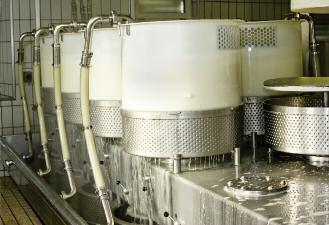
www.OK.org • 7
For those who are not intimately familiar with the cheese production process, it is hard to appreciate how much effort is required to produce kosher cheese.
must be cleaned and kashered correctly to the desired temperature. Then, in addition to procuring Cholov Yisroel milk for the cheese production, the starting cultures themselves must have been grown on a Cholov Yisroel media. These cultures can be obtained by growing four subsequent generations of cultures that were originally produced on non-Cholov Yisroel media.17 As these cultures are acquired from culture libraries supplying specialized blends of microbes designed to impart specific traits in the cheese, producing Cholov Yisroel (and kosher for Passover) versions also require a
mashgiach present during culture production. The silver lining to this is that Cholov Yisroel cheese production is more accommodating to the mashgiach in terms of Shabbos and Yom
Six-Hour Cheeses
A second aspect of cheese is the requirement to wait six hours after ingesting certain cheeses before eating meat, while most dairy products require a much shorter wait.18
Cheese that has been aged six months or become wormy (incidentally, as long as these worms never left the cheese, they may be con-
sumed)19, according to many authorities, are treated the same as waiting from meat to dairy.20 Fortunately, most kosher cheeses are not aged that long.
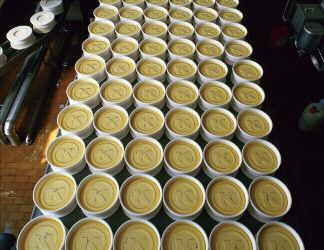
Before the existence of microbes was discovered, producing cheese was an act of constant trial and error, largely depending on atmospheric conditions to cure the cheese, which required long periods of time. Today, with our advanced understanding of microbiology, we are able to collate the precise desired microbes and add them, thus cutting down on the time required to process cheese.
For instance, Muenster cheese is not aged at all, since aging adds sharpness to cheese and a mild cheese would be detrimentally affected. Even Swiss cheese, which requires some aging to form the “eyes” (holes in the cheese) is not aged longer than four months, since prolonged aging dries out cheese causing cheese blocks to crack. However, many sharp cheddars and Parmesan cheeses are aged six months or longer. Regarding Parmesan, there are those who drop the six-hour rule if the cheese has been cooked or baked, so Parmesan on a salad would require a six-hour wait, while Eggplant Parmesan would not.21
While we don’t know exactly which cheese Yehudis supplied to the Greek general, consuming any sort of cheese satisfies this Chanukah custom (though I don’t think sour cream on latkes passes muster). This Chanukah, may we merit revealed miracles and celebrate salvation in our times.
18. Shulchan Oruch, Yoreh Deah, Siman 89:2.
19. Shulchan Oruch, Yoreh Deah, Siman 84, Rama.
33.
13. Shulchan Oruch, Yoreh Deah, Siman 87, Rama sif 10.
14. Shulchan Oruch, Yoreh Deah, Siman 115:1.
15. Shach, ois 20.
16. Shulchan Oruch, Yoreh Deah, Siman 115:1.
17. Shulchan Oruch HaRav, Orach Chaim, Siman 132:10.
20. Shulchan Oruch, Yoreh Deah, Siman 89, Taz, ois 4.
21. Yad Yehudah, Hilchos Basar V’Chalav, Siman 89:30.
8• www.OK.org
Tov
Today, with our advanced understanding of microbiology, we are able to collate the precise desired microbes, thus cutting down on the time required to process cheese.
1. Shulchan Oruch, Orach Chaim 670, Siman Beis, Rama.
2. Mishna Bruriah, sham, ois 10.
3. Shmuel I, 17:18 and Shmuel II, 17:29.
4. Iyov, 10:10.
5. Masechtas Avodah Zara 77, Daf 29b.
6. Shulchan Oruch, Yoreh Deah 115:2.
7. Beis Yosef on Tur, Yoreh Deah 115.
8. Igros Moshe, Yoreh Deah, Siman 38..
9. Igros Moshe, Yoreh Deah, Siman 50.
10. Igros Moshe, Yoreh Deah 2, Siman 48.
11. Shulchan Oruch, Yoreh Deah, Siman 87, Rama sif 12.
12. Shach ois
HUNTING
Smoking bees from their hive.
COOKING
Roasting food on coals or a grill.
TOOLS
Sharpening and fire-hardening digging sticks and spears.
6


MEDICINE
Cauterizing wounds to stop bleeding.
LANDSCAPE MODIFICATION
Clearing brush for ease of travel and hunting.
Fire, more spiritual than physical, provides light and warmth and is compared to the soul (Ki ner Hashem nishmas adam). Jews use fire to bring in Shabbos and Yom Tov, for Havdallah when we part with Shabbos, and to light our Chanukah menorahs... But did you know fire is also used for… 1 2 3 4 5 7 8
WOODWORKING
Recurve and reflex bows for hunting.
MODERN COMMUNICATION
FOOD PRESERVATION

Smoking meat to preserve it for long periods of time.
COMMUNICATION
Sending signals via smoke or campfire to other communities. (Rosh Chodesh)
Today, we use cell phones as a main means of communication. Did you know that the average person uses only 33% of their cell phone minutes and pays an average of $3.02 per minute?! 41% of cell phone users pay 50 cents per minute, less than 10% pay 10 cents per minute, and 11% pay $10 per minute! I guess talk isn’t so cheap after all!

www.OK.org • 9
Kosher Pickle
~ Kosher Co-Sponsors The Traveling Kosher Pickle Factory
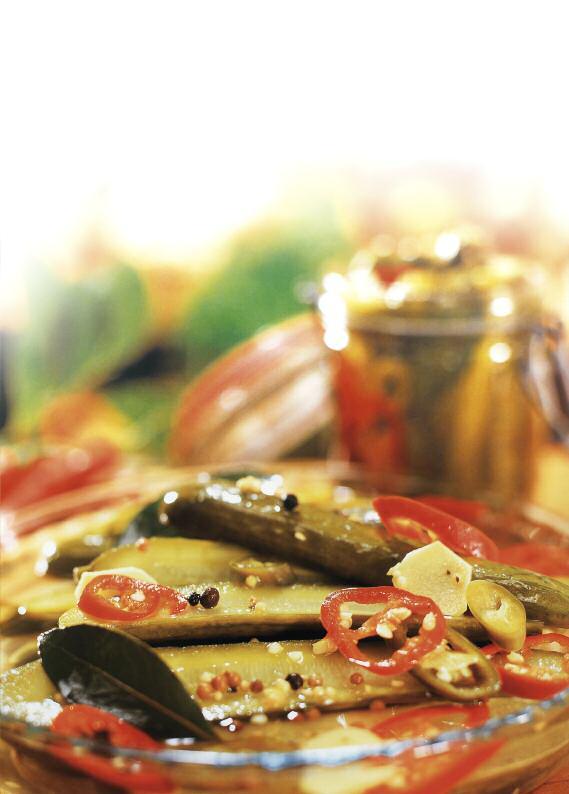 By David Brown
By David Brown
10• www.OK.org
The Traveling Kosher Pickle Factory was Rabbi Marcus’ brainchild. Marcus, the Chabad rabbi to Cypress, California would visit an 86year old former pickle-maker, for a Tefillin prayer and the crunch of homemade Kirby’s (not necessarily in that order). The two came up with an idea. Rabbi Marcus figured that the public school students he taught at Hebrew High would love to learn how to make a kosher pickle. The opportunity would allow him to surreptitiously slip a few kosher lessons in as well – while the rabbi learned about the pickle world, his students and audiences learned about the kosher world.
cheese and lox. Word of its popularity quickly leaked across the country.
Following requests, the Rabbi launched a national tour with shows in Chicago, Miami Beach, Boston, Las Vegas, and recently in New York’s Culinary Institute of America. Since the recent collaboration with the ~, the Traveling Kosher Pickle Factory is expected to reach 30,000 people over the next three years.
tical demonstration of kosher laws and symbols. In fact, he proudly notes, some participants have been so inspired by the unique approach, they have committed themselves to keeping kosher.
What he didn’t count on was the interest the eclectic program would engender among the teens’ parents. Over 200 phone calls poured in as adults vied for the opportunity to pickle their own cucumbers. Organizers had to turn people away as the program spread like wildfire across Southern California.
The course’s layout is similar to that of the popular Living Legacy Series, designed to teach about upcoming holidays through the Shofar and Matzah factories and the Olive Oil Press. Unlike the Living Legacy, though, this program is designed for an older audience.
Since it began in 2005, 7,000 people have prepared personalized pickle jars. During the hour-long presentation, participants choose their own spice combinations and tartness. According to Rabbi Marcus, adults prefer the deli pickle, associating it with traditional Judaism, much like a bagel shmeared with cream

One recent stop was at Hofstra University in New York. Rabbi Shmuli Lieberman welcomed the “Pickle Rabbi” and students on a snowy Tuesday night. Although the snowstorm left some in a pickle, the students who braved the weather loved the hands-on approach and the fact that they could make their own jar of kosher pickles to bring home.
Through humor and history, the Rabbi explains that kosher “is not a stylistic choice,” but rather, “something G-d wants us to do.”
One aspect the Rabbis emphasize is that sixty to seventy percent of what is in an average shopper’s cart is already kosher. Rabbi Marcus tells his audience that they are “eating more kosher than they think.” The goal, he says, is for participants to leave more kosherconscious through a prac-
“It’s all about keeping it kosher,” concludes Rabbi Marcus, on the program’s broader goal. With five million pounds of this popular snack consumed daily, there seems no better way to reach an audience and thanks to the support of the ~ this program has become a reality.
For more information on the Kosher Pickle Factory or to get a rabbi to give a kosher pickle class in your area, visit www.RabbiPickle.com.
www.OK.org • 11
kosHer “is not a stylistic cHoice,” but ratHer, “sometHing g-d wants us to do.”
How do you teach the basics of kashrus in a captivating, relevant way? This is a question that the ~ education department deals with on a regular basis and was the catalyst for our sponsorship and support of a unique, stimulating kosher education program—The Traveling Kosher Pickle Factory.
Healthy Spirit
Traditional Chanukah Foods
Cheese Potatoes
5Since potatoes predominantly contain carbohydrates, they are easy to digest and facilitate digestion.
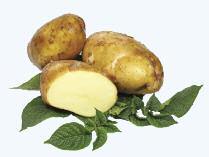
5Potatoes contain vitaminC and B-complex and minerals like potassium, magnesium, phosphorus and zinc, which are good for the skin.
5Pulp obtained from crushed raw potatoes, mixed with honey, can serve as excellent skin and face masks.
5Potato pulp, if applied externally on burns, gives a quick relief and aids in healing.
Olive Oil
Olives grow on trees, so olive oil is technically a fruit juice rather than an oil. The olives are pressed to release their juices just like oranges and lemons are pressed.
In Ancient Greece, people applied olive oil to their skin and hair as protection from the elements and to maintain a pleasant fragrance.
Using olive oil in place of other oils offers protection against heart disease by controlling LDL ("bad") cholesterol levels while raising HDL (the "good" cholesterol) levels.
Olive oil's protective function has a beneficial effect on ulcers and gastritis.
Extra virgin olive oil, from the first pressing of the olives, contains the highest levels of antioxidants, particularly vitamin E and phenols, because it is less processed than other grades of olive oil.
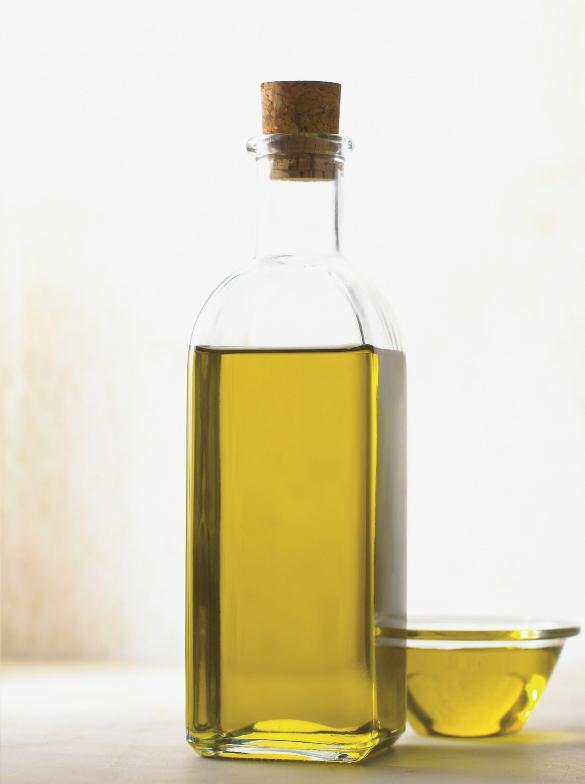
5Apart from having very high calcium content, cheese is also rich in vitamin-B, which is very good for children, women, and elderly people, for formation and strengthening of bones and cartilages. The vitamin-B aids proper absorption and distribution of calcium.
5Certain cheeses such as Cheddar, Swiss, blue, Monterey Jack, and processed American cheese, among others, have been demonstrated to reduce the risk of dental cavities.
5Many cheeses, particularly aged cheeses such as Cheddar and Swiss, contain little or no lactose. For this reason, cheese is an important source of calcium and many other nutrients found in milk for lactose maldigesters or persons who have difficulty digesting lactose or milk's sugar.
5Cheese, in moderation, is included in the DASH (Dietary Approaches to Stop Hypertension) diet designed to reduce the risk of hypertension.

12• www.OK.org
Zucchini parmesan Latkes (Dairy)

2 pounds zucchini
1/2 pound russet potatoes, peeled
1/2 tablespoon lemon juice
1 cup chopped scallions
1/2 cup grated Parmesan cheese
1 teaspoon chopped garlic
3/4 cup chopped parsley
1 teaspoon salt

1/2 tablespoon pepper
2 teaspoons sugar
1/3 cup flour
2 medium eggs
Peanut oil for frying
1. Grate the zucchini and potatoes and toss in the lemon juice to prevent browning. Squeeze the zucchini and potatoes through towels or a sieve. It is imperative that you get almost all the moisture out of the vegetables.
2. Add the scallions, cheese, garlic, 1/2 cup of the parsley, salt and pepper, sugar, flour, and eggs and toss to make sure that the ingredients are well mixed.
3. Heat a 1/2 inch of peanut oil in a pan until hot and add thin silver dollar-size pancakes, frying over high heat until golden brown and crispy. When serving, sprinkle with a little more salt and the remaining chopped parsley.
Yield: 24 pancakes
C h a n u k a h r e c i p e
www.OK.org • 13
The Jewish People are a nation of traditions. Our customs sometimes travel back thousands of years.
The Jewish calendar is sprinkled with joyous holidays, celebrated in the synagogue with prayer sung to ancient melodies and in the home with family meals; recipes passed down from generation to generation.
Today a cook has a variety of resources when she looks to plan her holiday menu. She may turn to family heirlooms, recipes kept and cherished from years of old or she may gather recipes from friends, cookbooks, and weekly magazines.

The Kosher Spirit is excited to showcase Let’s get Cookin’ a new and creative recipe organizer developed by Tzivi Eichenholz and Chavi Wilner, two “balabustas” [Yiddish for good homemakers] living in Brooklyn, NY. Let’s get Cookin’ allows you to add, organize, share, and browse through all of your favorite recipes in one place. it takes old traditional recipes and thrusts them into the modern era and will instantly create shopping lists and help in planning your menu.
The Kosher Spirit sat down with Tzivi and Chavi to discuss Let’s get Cookin’.
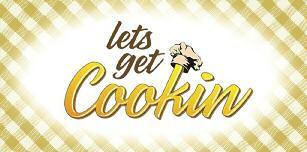
14• www.OK.org
Kosher Spirit: What was the inspiration for this project?
Tzivi Eichenholz: I’d had enough of fruitless searching for recipes that I had scribbled on the back of envelopes. I wanted to create a place that would sort and assemble my recipes in a comprehensive and easyto-use manner.
Chavi Wilner: My children grew tired of eating the same old chicken soup so I started collecting recipes and trying new foods but soon I had so many recipes in so many places I could not find what I needed when I needed it.
KS: How did you meet?
CW: Our children learn in the same school, and once while chatting I expressed frustration with organizing all my loose recipe clippings and Tzivi knew exactly what I meant. We decided that we would team up to find the best solution and the rest is history!
KS: How did you get started?
TE: We tried other recipe programs and weren’t satisfied, so we hired a group of programmers, put a lot ofbrainpower and “yiddishe kup” in one room and we worked to make it right.
KS: What is unique about this software?
TE: Let’s Get Cookin’ is the only kosher recipe organizer in the world! It is very easy to use, incorporates the Jewish Calendar so you can see when Yom Tov comes out and plan your menu, features video presentations on food garnishing, includes ~ Kosher Certification’s Guide to Checking Vegetables, and as a bonus, has hundreds of kosher recipes included. It also does not require an Internet connection.

CW: We included Devorah Heller’s Challah Workshop in our program. Devorah is famous worldwide for her fast and easy method to make challah. Devorah takes you on a journey through the spiritual significance of making challah and describes the
beauty of this important mitzvah.
After learning to make challah using Devorah’s video tutorial, I now consider myself a pro!
KS: How are recipes added to the program?

CW: There are two easy ways to add recipes. You can manually enter recipes you’ve collected over the years, and, our software also allows you to select any recipe you’ve found from cooking sites, recipe collections and food blogs and easily import it into the program.
KS: How about printing and sharing recipes?
CW: We have a wonderful feature where you can print the recipes on index cards formatted to print in high design. Our import feature is a favorite! It allows friends to easily share recipes with just a few simple clicks, it is a real time saver!
KS: The variety of features is fascinating, please tell our readers more!
CW: For a timesaving specialty, check out our Shopping Lists. Just select the recipes you’ve planned to use for a Shabbos or Holiday meal and in seconds you will have all the necessary ingredients for all of the recipes you’ve chosen added to your shopping list. Additionally, recipes are customizable; planning a Bas Mitzvah? Need to feed a large crowd and your favorite recipe only feeds six? Simply adjust the recipe yield and it will automatically adjust the ingredient amounts.
KS: How has the ~ been involved with this project?
TE: The ~ has been so helpful! It has been such a pleasure to work with the staff of the ~ on this project. Their dedication to kosher and their professionalism and sweetness
impressed us. The ~ contributed to this program by providing the user with quick and accurate kosher information, tailored to a recipe’s needs. For example, when you search for a vegetable using the search bar, you will find step-by-step instructions on how to inspect it properly for insects. When entering in a new recipe that includes a vegetable which needs checking, a reminder will pop up guiding you through the process. (It’s really cool!) A special tab was added to make the entire ~ Vegetable Checking guide easily accessible at any time.
KS: any final thoughts?
TE: Yes. This program can be used as a powerful fundraising tool for schools and charities as the recipes can be shared and customized to your community’s needs.
KS: Where can i pick up a copy of let’s Get Cookin’?
TE: By the time you read this article, we expect most Judaica stores to be carrying it.
CW: You can also purchase a CD by emailing info@onlykosher recipes.com or calling Tzivi at 917.455.2468 or myself at 347.846.8276.
www.OK.org • 15
in Action!










at the 11th Annual ~ Mashgichim Conference


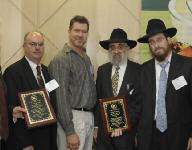
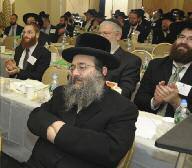

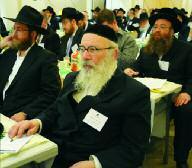
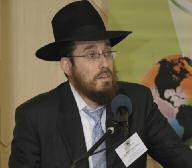 Rabbi Yitzchak Hanoka
Rabbi Loewenthal, Denmark
Mr. Ken Aicardi and Mr. Adam Self accepting Featured Company award on behalf of Costco
Rabbi Don Yoel Levy
Rabbi Yitzchak Hanoka
Rabbi Loewenthal, Denmark
Mr. Ken Aicardi and Mr. Adam Self accepting Featured Company award on behalf of Costco
Rabbi Don Yoel Levy
16• www.OK.org
Rabbi Aaron Weiss
HaRav Usher Anshel Eckstein, Dayan of the Belzer Kehilla



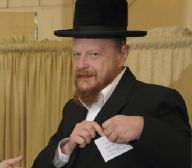








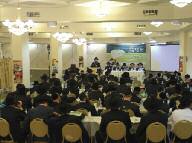
3rd edition of the popular ~ VEGETABLE CHECKING GUIDE Helping you do things right Available FREE at your local ~ certified restaurant or download a PDF @ www.OK.org BACK BY POPULAR DEMAND!
Rabbi Teller, Belgium
~ 2009 Mashgichim Conference
WHO’S BEHiND THE ~
~BEHiND
Interview with Rabbi Yitzchak Gornish
Rabbi Yitzchak Gornish
KS: Where did you grow up? Where did you go to yeshiva?
RYZG: I grew up in Flatbush, Brooklyn. For yeshiva, I attended Yeshiva Torah v’Daas in Flatbush; Beis Talmud, Bensonhurst; and, MirYerushalayim. I eventually received semicha from Beis Midrash Gevoha in Lakewood. The ~ also sponsored my Bachelor of Science in Biology from Touro College and later a Master of Science degree in Food Science from Rutgers University.
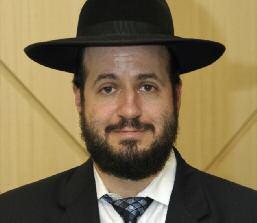
KS: What did you do after yeshiva?
RYZG: After yeshiva, I started working as a mashgiach at different hashgocha agencies such as the Orthodox Union, the Star-K, and the Vaad of Queens.
KS: What is your current position at the ~?
RYZG: I currently head the Formula Review and Ingredient Submittal Department. I am also the Rabbinic Coordinator for Food Service, Restaurants & Caterers.
KS: What prepared you the most for your current position at the ~?
RYZG: My varied experiences in hashgocha and my academic degrees prepared me for my current work at the ~

KS: What is best thing about working at the ~?
RYZG: The best thing is working with great people who are conscientious of the importance of kashrus. I feel priv-

ileged to work with the other ~ rabbis. Kashrus is a never-ending learning experience, and I am able to call on the experience of my colleagues for continual insight into a variety of kashrus matters.
KS: How would you describe the ~ today?

RYZG: The ~ is a pioneer, a visionary in kashrus and is sensitive to the needs of all who work on its behalf. Each Rabbinic Coordinator has had previous field experience. This is very beneficial when it comes to dealing with kashrus problems. It also helps us to establish better relationships with the mashgichim in the field. Once you have been in someone’s position, you relate with more sensitivity.
KS: Can you share an interesting experience that you had while working at the ~?
RYZG: During one of my visits to Japan, I found myself stranded at the airport due to a snowstorm.Determined to conduct my inspection, I inquired how to travel by train.A ticket agent gave me directions and called the facility (he spoke much better Japanese than me) to ensure someone would pick me up at the train station.After hours of traveling, I found myself alone in a small village just as it was getting dark. Apparently there was some type of miscommunication between the ticket agent and the facility, because no one was there to meet me. Passersby were of no assistance due
18• www.OK.org
MeeT our STAff:
to the language barrier. I trudged through the snow in the dark with my luggage for what felt like forever. Finally, I came across a building that had a flashing emergency light attached — it was a first aid building. I went inside and found a boy who in broken English explained that I would never be able to reach my destination due to the weather. After a little coaxing, he offered to give me a ride to the facility in an ambulance. When I arrived at the facility, in an ambulance in the middle of a huge snowstorm I wish I would have taken some pictures of their shocked faces. Unfortunately my guide was no longer there, and there were no more English speakers working. With the interpreter’s help on the phone, I conducted my inspection. While it was difficult to ask questions and to read the labels printed in Japanese, I was able to successfully complete my inspection!
What Other People Say About Rabbi Yitzchak Gornish


“
Rabbi Gornish is a talmid chochom and master in Chemistry who is well-known for his spellbinding lectures. His broad knowledge contributes greatly to the kashrus world. With his vast experience in many areas and his youthful energy, Reb Yitzchak is one of the new generation of ~ rabbis who ensures that the ~ will always be the pioneers in kashrus.
Rabbi Don Yoel Levy, Kashrus Administrator, ~ Kosher Certification
When the Torah wants to describe the word of Hashem – the word of Emes, the Torah tells us to ignore the loud noises and pushy opinions. Rather, we should pay attention to the softer and steady voice. i believe this can describe my good friend, Reb Yitzchak. There are many voices in a conversation but his soft, steady thoughts and opinions are usually the prevailing voice of emes.
Rabbi Sholem Fishbane, Kashrus Administrator – CRC-Chicago
Rabbi Gornish makes himself available day and night in order to ensure that our restaurants meet the kosher standards we set for them. His Master’s degree in Food Science allows him to approve restaurant ingredients in an incredibly efficient manner. Due to his background in hashgocha, he is able to understand the nature of restaurants and caterers, and is sensitive to all the details that go into certifying them.
Rabbi Naftali Marrus, Rabbinic Coordinator – Restaurants & Catering


“His broad knowledge contributes greatly to the kashrus world”
www.OK.org • 19
– Rabbi Don Yoel Levy, Kashrus Administrator, ~ Kosher Certification
iSRaEl vodka
CANADiAN goLD
BeverAgeS
CaNaDa
Flavored Sparkling Water
CASA De oro fooDS
NE, USa
Tortillas/Taco Shells
Ce orgANiCS
BC, CaNaDa
Bases & Syrups
CherrY griLL
NEW JERSEY, USa
Meat Restaurant
ChuNg MiN LiNerBAgS (huiZhou) LTD.
GUaNGDONG, CHiNa
Packaging
CiNe CiTTA griLL
FlORiDa, USa
Dairy Restaurant
CoNServerA AMAZoNiCA
lORETO, PERU
vegetables (Canned)
CoSMoS AroMATiCA
iNTerNACioNAL, S.A.
BaRCElONa, SPaiN
Flavors
DeLfi CACAu BrAZiL LTDA
BRaZil
Cocoa products
DeriCheM (M) SDN. BhD.
PENaNG, MalaYSia
Soap Noodles
DeuTSChe Bp AKTieNgeSeLLSChAfT, iNDuSTriAL
LuBriCANTS & ServiCeS
GERMaNY lubricants and Mineral Oils
eDeLWeiSS ToWN hALL
CheeSe Co. (pLANT #55-188)
WiSCONSiN, USa
Dairy Products
eieio, iNC.

TExaS, USa
Flavoring Extracts
eLiTe CooKieS iNC.
NEW YORK, USa
Cookies & Crackers
eox, LLC DBA go2
iNTerNATioNAL

CaliFORNia
Water Sanitizer
fABriCA De MAiCeNA iriS
CiA LTDA
PiCHiNCHa, ECUaDOR
Rice & Rice Flour
fiSh, fiSh AND CANNoLi
BROOKlYN, NEW YORK, USa
Dairy Restaurant
freSCo hAZevA 2006
iSRaEl
Packaged vegetables
fuSo CheMiCAL Co., LTD.
OSaKa, JaPaN acids & acidulants
20• www.OK.org 107 WAYS ~ Koshered your world in 2009! AArhuSKArLShAMN LATiN AMeriCA S.A. MONTEviDEO, URUGUaY Oils and Specialty Fats ADegerMex, S.A. De C.v. ESTaDO DE MExiCO AMeriCAN hArveST BAKiNg Co., iNC. D/B/A AhB fooDS NEW JERSEY, USa artisan Breads ArTWorK CooKieS & CAKeS NEW YORK, USa Cakes and Cookies AuerBACh’S MeAT CoMpANY COlORaDO, USa Glatt Kosher Meat (Chassidishe Shechita) BAiShui ANDre JuiCe Co.,LTD SHaaNxi PROviNCE, CHiNa Juice & Juice Concentrates BALDor SpeCiALTY fooDS NEW YORK, USa Packaged vegetables BeiJiNg huiYuAN group JiZhoNg fooD AND BeverAge Co., LTD HEBEi, CHiNa Juice & Juice Concentrates BeNiCor u.S.A. NEW YORK, USa BiTe WiSe BROOKlYN, NY, USa Baked Goods BioDieSeL pALDiSKi AS ESTONia Esters, Glycerines & Oils BLue SeASoN iNTerNATioNAL LTD
NeW CoMpANieS
gALiL reSTAurANT
NEW YORK, USa
Meat Restaurant
giDroN iNDuSTrieS
iSRaEl
Bakery
gLATT KoSher fAMiLY, iNC.
NEW YORK, USa
Meat Restaurant
gourMeT MuShrooMS
CaliFORNia, USa
Fresh Mushrooms & Nutritional
Supplements
greeN MeADoWS fooDS
iOWa, USa
gvf ALiMeNToS LTDA
CHilE
Fruit (Dried), Nuts & Seeds
hAiNAN xiNTAiSheNg iNDuSTrY Co., LTD
HaiNaN, CHiNa
Fish Products
heALThY TeMpTATioNS
NEW YORK, USa
Dairy Cholov Yisroel Yogurt
heBei feNgTe fruiT & vegeTABLe JuiCe Co
HEBEi, CHiNa
Juice & Juice Concentrates
J h hANAN NEW YORK, USa
Baked Goods
JeruSALeM 2 MArKeTpLACe NEW YORK, USa
Dairy Restaurant
JeruSALeM gLATT KoSher
reSTAurANT NEW JERSEY, USa
Meat Restaurant
JiAxiNg TAiSheNg Life
fooDS Co., LTD
ZHEJiaNG, CHiNa
vegetables (Frozen)
JohNSoN & JohNSoN
CoNSuMer iSrAeL
(A DiviSioN of J-C heALTh CAre)
iSRaEl
listerine
KATLAv WiNerY LTD
iSRaEl
Wine
KerrY oLeoCheMiCAL
iNDuSTriAL (ShANghAi) Co.,
CHiNa
Glycerine
KiMMie CANDY CoMpANY
NEvaDa, USa
Candies
KoSher KArT LLC
NEW YORK, USa
Meat Carts
KoSher veNDiNg CAfe
NEW YORK, USa
Meat vending Machines
LuNCh Box
NEW YORK, USa
Dairy Restaurant
MAAS refiNerY B.v.
ZUiD-HOllaND, NETHERlaND
Refined Oils
MATerNe
FRaNCE
Fruit (Candied)
MiSSioN BioTeChNoLogieS

SDN BhD
SElaNGOR DaRUl EHSaN, MalaYSia
Glycerine
NATure SoY
PENNSYlvaNia, USa Soy and Tofu products
NeSTLe DeuTSChLAND Ag-
fACTorY BieSSeNhofeN
BavaRia, GERMaNY
Materna- baby formula
NeSTLe iNDiA LiMiTeD
HaRYaNa, iNDia
Tea
NeT CACAo
FRaNCE
NorDiC SugAr A/S
DENMaRK
Sweeteners
NTrA. SrA. De LAS virTuDeS
SPaiN Olive Products
oLgA’S oN SMiTh
NEW YORK, USa
Dairy Restaurant
oLiveST
illiNOiS, USa Oil & Shortenings
pAgYSA pAMuK giDA YerLi
uruNLer TiC. ve SAN. A.S.
TURKEY
Dried Fruits
pAKiSTAN SeSAMe MiLLS
SiNDH, PaKiSTaN
Sesame and Tahini Products
pALiSADiuM MANAgeMeNT
Corp.
NEW YORK, USa
Caterer
perfeCT reNAiSSANCe LTD
iSRaEl Wine
piDY gourMeT
NEW YORK
Pie and Dessert Shells
pieDMoNT CANDY CoMpANY
NORTH CaROliNa, USa
Candy and Chocolates
piZZA MANiA
FlORiDa, USa
Dairy Restaurant
piZZA NoSh oN J
NEW YORK, USa
Dairy Restaurant
preMiuM fooDS LTD.
iSRaEl Chocolate
pro-AMiNo iNTerNATioNAL
QUEBEC, CaNaDa
Health Bars
pT. WiLMAr BioeNergi
iNDoNeSiA
RiaU, iNDONESia
Glycerine
pureLY AMeriCAN
OHiO, USa
Soup Mixes and Beans
QiN’AN greATWALL fruiT
JuiCe & BeverAge Co., LTD
GaNSU, CHiNa
Juice & Juice Concentrates
rAfAeL’S BAKerY
NEW YORK, USa
Bakery
roDLeBeN CheMie gMBh
GERMaNY
Emulsifiers & Stabilizers
ruShAN heNgYu fooDSTuff
SHaNDONG, CHiNa
Fruit (Canned)
rZ DiSTriBuTorS of freSh
MeAT, iNC.
NEW YORK, USa
Meat
SABABA gourMeT, iNC.
NEW YORK, USa
Frozen Foods
ShAANxi MiNgrui
AgriCuLTure
DeveLopMeNT Co., LTD
SHaaNxi, CHiNa
Juice & Juice Concentrates
ShANDoNg QiNgguo fooDS.,LTD
SHaNDONG, CHiNa vegetables (Frozen)
SiChuAN DeYi greeN fooD
SiCHUaN, CHiNa instant Rice
SoCo CreAMerY
MaSSaCHUSETTS, USa ice Cream
STiLL riDiNg piZZA
CONNECTiCUT, USa
Gluten Free Pizza Crusts
STYLe JeruSALeM
NEW YORK, USa
Bagels, Pitas & laffas
SupreMe MANufACTuriNg CoMpANY, iNC
NEW JERSEY, USa
Bases & Syrups
SYfAN Mfg
NORTH CaROliNa, USa
Plastic Products
TAKe 2 Dough proDuCTioNS, iNC.
MaiNE, USa
Pizza Dough/Crusts
TAT NiSASTA SAN. TiC .A.S.
TURKEY Glucose
TrADiTioNAL BAKerY
NEW JERSEY, USa
Baked Goods
Tru-ChoCoLATe D/B/A
MeChANiCS of WeALTh
MaiNE, USa Chocolate
uNiLep SAS
FRaNCE Dairy Products
WALDNieLer fruChTSAfT
gMBh
GERMaNY
Juice Concentrates
WeiNSoN WiNerY NEW YORK, USa Wine
WheATLeY BAKerY NEW YORK, USa
Bakery
WheATLeY piZZeriA NEW YORK, USa
Dairy Restaurant
WhoLeSoMe SpiCe & SeASoNiNg Corp. NEW YORK, USa
Seasonings & Spices
WiSCoNSiN SpeCiALTY proTeiN
WiSCONSiN, USa
Dairy Products
xiANYANg ANDre JuiCe Co.
SHaaNxi PROviNCE, CHiNa
Juice & Juice Concentrates
xuZhou ANDre JuiCe Co.
JiaNGSU, CHiNa
Juice & Juice Concentrates
YANTAi LoNgKou ANDre Co., LTD
SHaNDONG, CHiNa
Juice & Juice Concentrates
YANTAi Luxe vegeTABLe fooDS CoMpANY LTD.
SHaNDONG, CHiNa
Frozen Fruits and vegetables
YoNgJi ANDre JuiCe Co.
SHaaNxi PROviNCE, CHiNa
Juice & Juice Concentrates
ZeeLANDiA h.J. DoeLeMAN
NETHERlaNDS
ZheJiANg Nhu CoMpANY
ZHEJiaNG, CHiNa
Food additives
ZMY fooD pACKiNg iNC.
NEW YORK, USa
Smoked Cheese
www.ok.org for a complete list of certified companies and their products. www.OK.org • 21
visit
ChANuKAh: Victory of the Soul
Compiled by Dina Fraenkel
The Talmud asks in Tractate Shabbos, “What is Chanukah?” According to Rashi, the real question is, “What is the miracle that we celebrate on Chanukah?”
The Talmud answers: “When the Hellenists entered the Beis HaMikdash, they defiled all of its oil. Then, when the royal Hasmonean family overpowered and was victorious over them, they searched and found only one cruse of pure oil... sufficient to light the menorah for a single day. A miracle occurred and the Maccabees lit the menorah with this oil for eight days.”
Based on this answer, there are two miracles of Chanukah: the physical victory of the Jews over the Greeks, a tiny band of soldiers versus the most powerful army in world, and the spiritual victory of finding one unspoiled cruse of oil, which miraculously lasted for eight days instead of one. Why is the specific miracle that warranted the establishment of Chanukah the seemingly lesser miracle, the cruse of oil, rather than the more obvious, “larger” miracle of the victory of the few over the many?
The “smaller,” spiritual miracle is celebrated, because the Jews did not really face a threat to their physical lives during the Greek occupation. Rather, the Greeks wanted the Jews to forsake their spirituality, to remove Hashem from their lives. The Greeks demanded of the Jews, “Inscribe upon the horn of an ox that you have no part in the G-d of Israel.”1 In actuality,
the war between the Jews and the Greeks occurred because the Jews courageously ignored the decrees against Judaism and belief in Hashem
The real miracle, therefore, is the miracle of “rescuing the soul of the people”. The miracle of the oil, a miracle connected to a mitzvah involving the lights in the Beis HaMikdash, was the true miracle. As the Torah says, “For a mitzvah is a lamp and Torah is light.”
Even though we understand the priority of the spiritual miracle, another question still remains. Why doesn’t the Talmud refer to the physical victory in battle as a miracle? Despite the main miracle, the spiritual miracle, was the physical victory not miraculous as well? It was the physical victory that allowed the spiritual victory to occur – the Maccabees would not have had any access to the Beis HaMikdash if the Greeks had been victorious.
The battle of the Greeks versus the Jews was not against the practice of Judaism, rather the Greeks were against the presence of Hashem in Torah and mitzvos. As it says in Ve’Al HaNissim: “to make them forget Your Torah and make them violate the decrees of Your will.” The Greeks wanted to erase the Divinity of Torah and mitzvos.
The war waged by the Greeks was against the Jewish belief that Hashem is above everything, that Hashem transcends nature, that Hashem cannot be quantified by human intellect.
This is why the Talmud speaks of the miracle of the oil as the miracle that brought about the celebration of Chanukah. The Chanukah lights symbolize the spiritual victory, the illumination of Hashem’s light in the darkness. This spiritual miracle is so great, so awesome, that it completely eclipses the physical victory of the Maccabees over the Greeks.
It is the entirely spiritual nature of Chanukah that helps us to achieve such a high spiritual level, where the soul is so superior to the body that the body becomes almost an afterthought. Even though the soul is clothed in a body, and our souls need a body in order to serve Hashem, the body is dominated by the soul and its Divine nature. A person’s entire physical self is devoted to helping the soul fulfill its spiritual service.
This Chanukah as we kindle the miraculous lights and recite the Ve’Al HaNissim prayer, let us also ask Hashem to help us use our bodies to aid our souls in their Divine purpose, to bring the end of Golus and usher in the Geulah Shleimah

22• www.OK.org ChASSiDiC iNSighTS
1.Bereishis Rabbah 2:4
Let There Be Light ~
Kosher by the Numbers
10,000
Nearly 10,000 food plants in the US produce kosher items.
Supermarkets that carried about 17,000 certified kosher items only 5 years ago are now featuring nearly products.
20,000 120,000
Total of items certified kosher in the United States.
Estimated percentage of a supermarket’s food products are kosher:
356,226 lbs. 40%
Total amount of food distributed to the Jewish poor, up 9.2% over last year.
The light that Hashem created on the 1st day of creation was very special and different from the light that you and I utilize every day. The light that we know was created on the 4th day when Hashem created the sun, moon and stars. The light from the first day was created and then hidden away. It is called the Or HaGanuz (Hidden Light). Hashem saw that the wicked were unworthy of using that light, so He hid it for special occasions. It was with that light that Adam HaRishon could see from one side of the world to the other (Chagigah 12a).
It took Moshe Rabbeinu 36 days to explain the Torah to the Jewish people (Seder HaOlam Rabbah 10).
Moshe Rabbeinu had the power to use the Or HaGanuz as well. He was born 36 years after the oppression in Egypt began.
When Moshe Rabbeinu was born, the Torah says the house filled with light (the Or HaGanuz). There is a tradition (not often practiced) that the Tes in “Va’yar ki tov” has 4 crowns (the letter Tes usually only has 3 crowns), because the numerical value of Tes is 9, and 4x9=36.
The phrase Lamed Vov Tzaddikim (the numerical value of Lamed Vov is 36) can mean, “These are the tzaddikim that have use of the Or HaGanuz.”
Light is also connected with the number 25:.
25 is connected to the light created on the 4th day, the light that we know and use.
45% 1,236
Nearly 45% of all kosher consumers in 2009 are below the age of 45, an increase from about 35% just five years ago.
The Or haGanuz is connected to the number 36: When Adam HaRishon was created, there were 36 hours of light from the Or HaGanuz (12 hours on Friday and the entire 24 hours of Shabbos). It became dark for the first time MotzeiShabbos and that is why we make a brocha on fire MotzeiShabbos, in appreciation of Hashem giving fire to bring light to Adam.
The B’ney Yissachar writes that the Or HaGanuz was also hidden in the Chanukah candles. It is no surprise then that we light 36 candles on Chanukah (in total without the shamash)!
Chanukah is on the 25th day of the month of Kislev.
The 25th word in Torah is Or.
The Torah says, “Yehi Or. There was light.” Yehi = 25.

We now have a deeper insight into the question that G-d asked Adam: “Ayeka? Where are you?”
number of scheduled and surprise visits the ~ made in Sept. 2009.
The Or HaGanuz is also hidden in the Torah and it has been said that there are 36 references to light in the Torah.
Aleph Yud Kof Hey = 36, but it can also be split into two words: “Ayeh Kof-Hey? Where is the 25?” meaning, “What did you do with the light that you used?”
www.OK.org • 23 SouL NuTriTioN
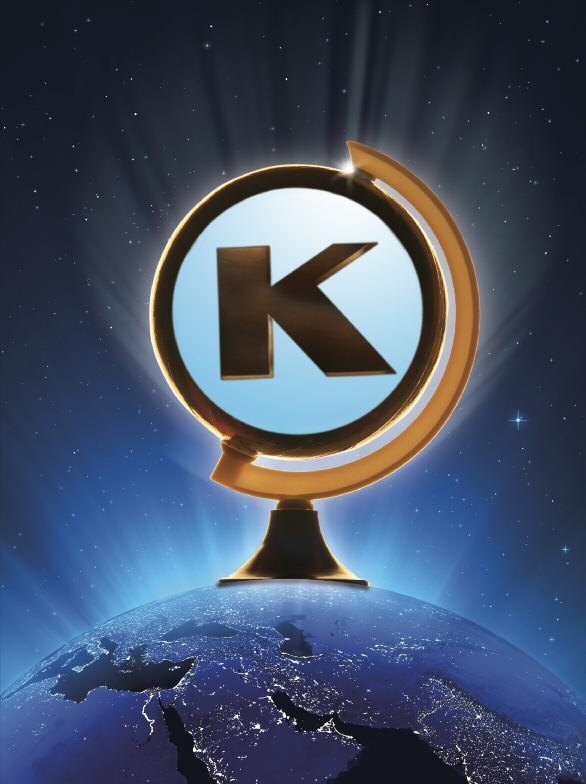

Kosher Without Compromise. KOSHER CERTIFICATION ~ Kosher Spirit, 391 Troy ave., Brooklyn, NY 11213 718-756-7500 • info@ok.org • www.ok.org



 Joe Polansky
Joe Polansky



 By Rabbi Yitzchak Gornish
By Rabbi Yitzchak Gornish










 By David Brown
By David Brown





















 Rabbi Yitzchak Hanoka
Rabbi Loewenthal, Denmark
Mr. Ken Aicardi and Mr. Adam Self accepting Featured Company award on behalf of Costco
Rabbi Don Yoel Levy
Rabbi Yitzchak Hanoka
Rabbi Loewenthal, Denmark
Mr. Ken Aicardi and Mr. Adam Self accepting Featured Company award on behalf of Costco
Rabbi Don Yoel Levy





















